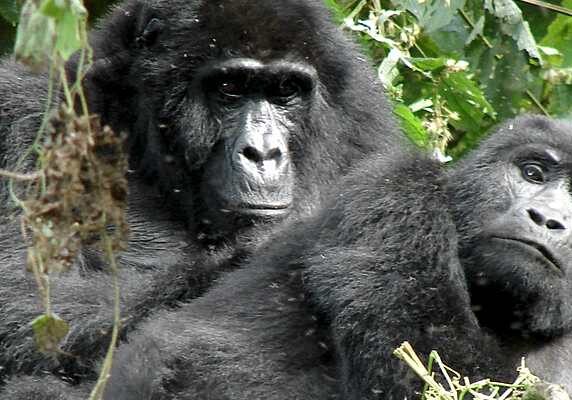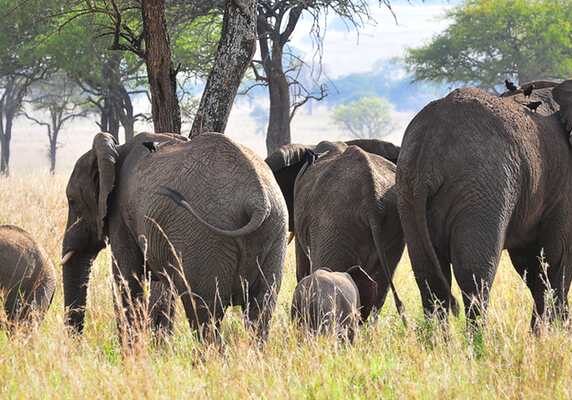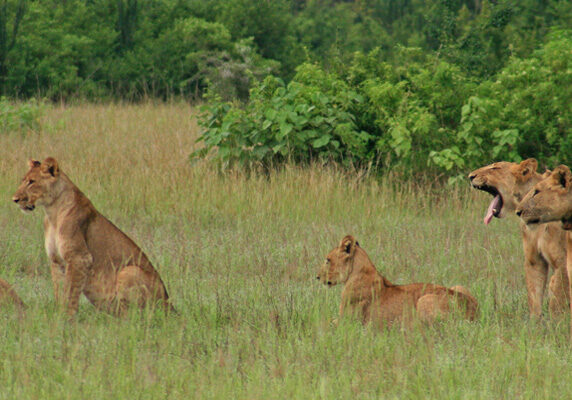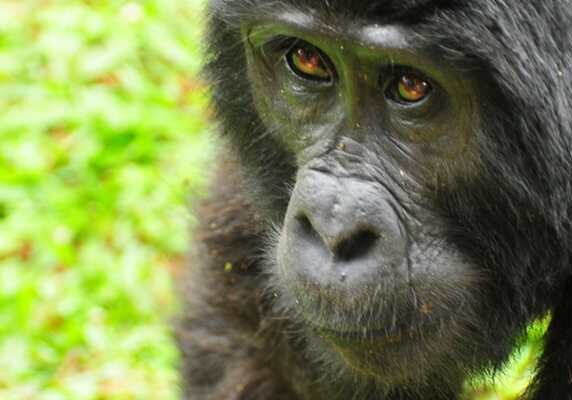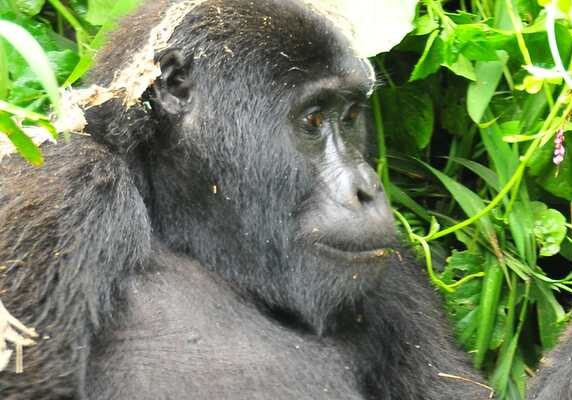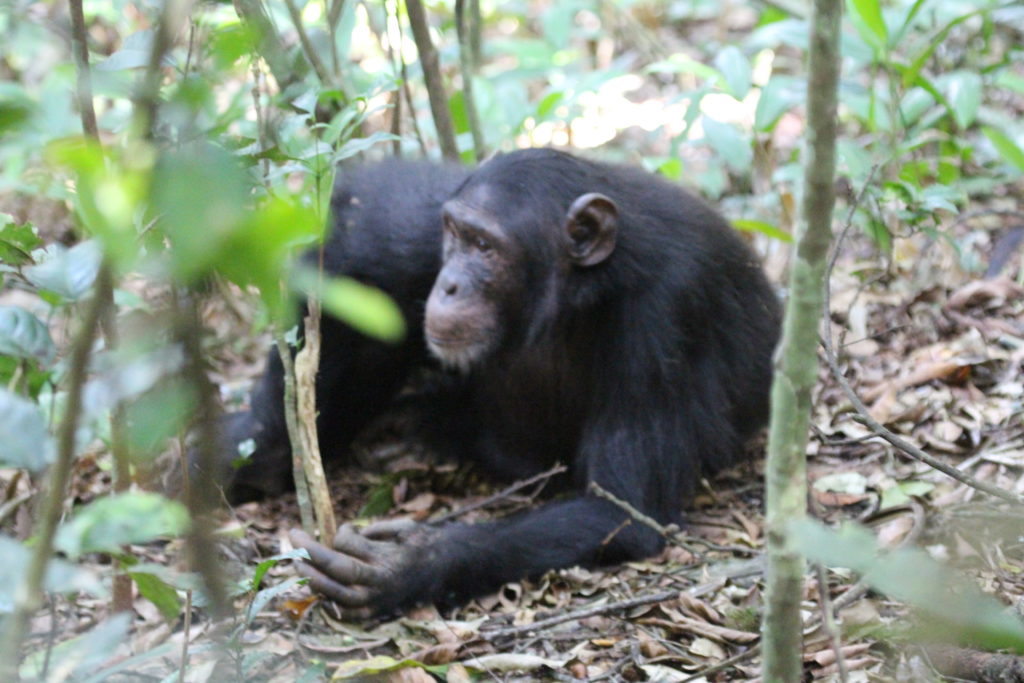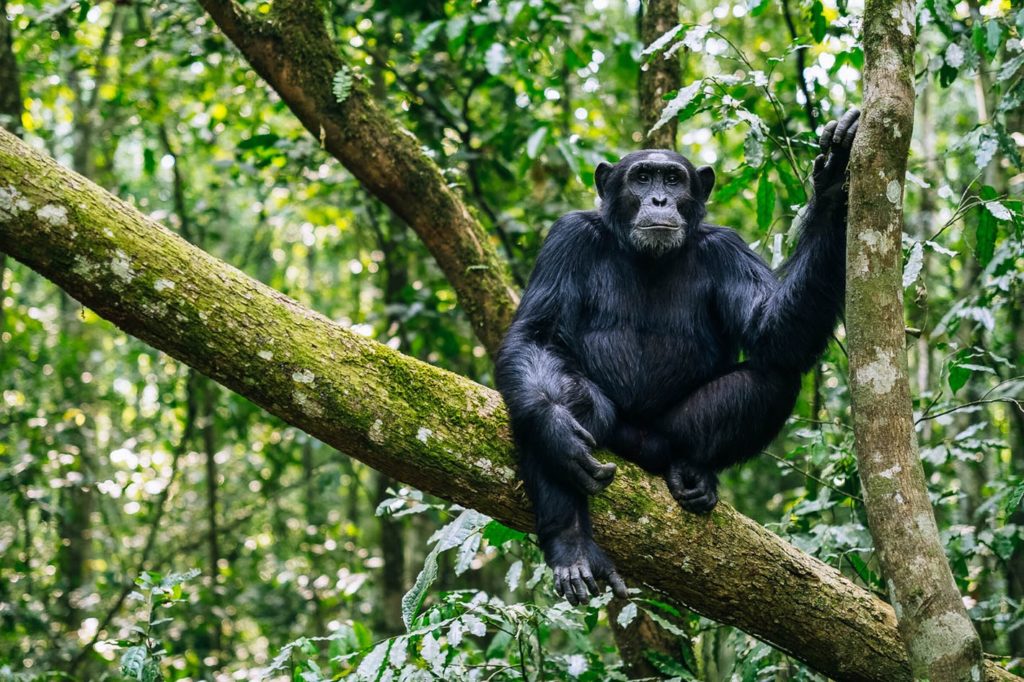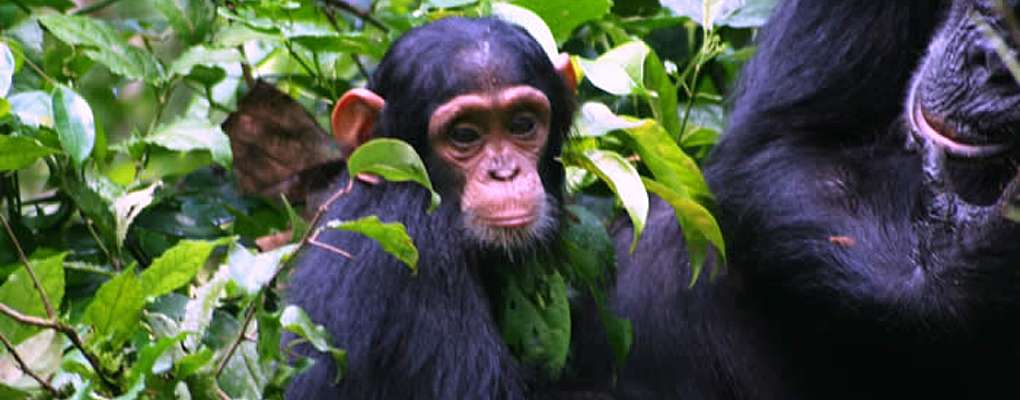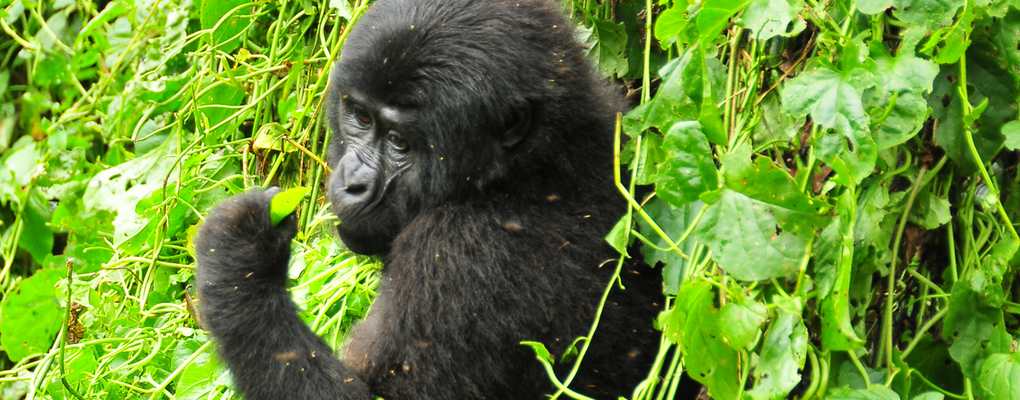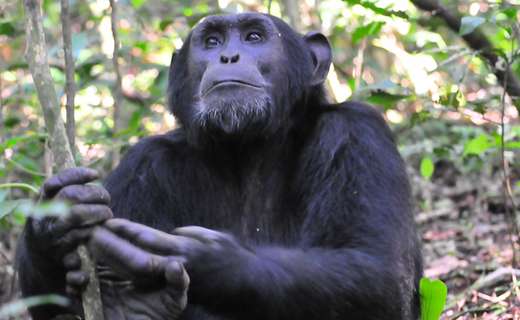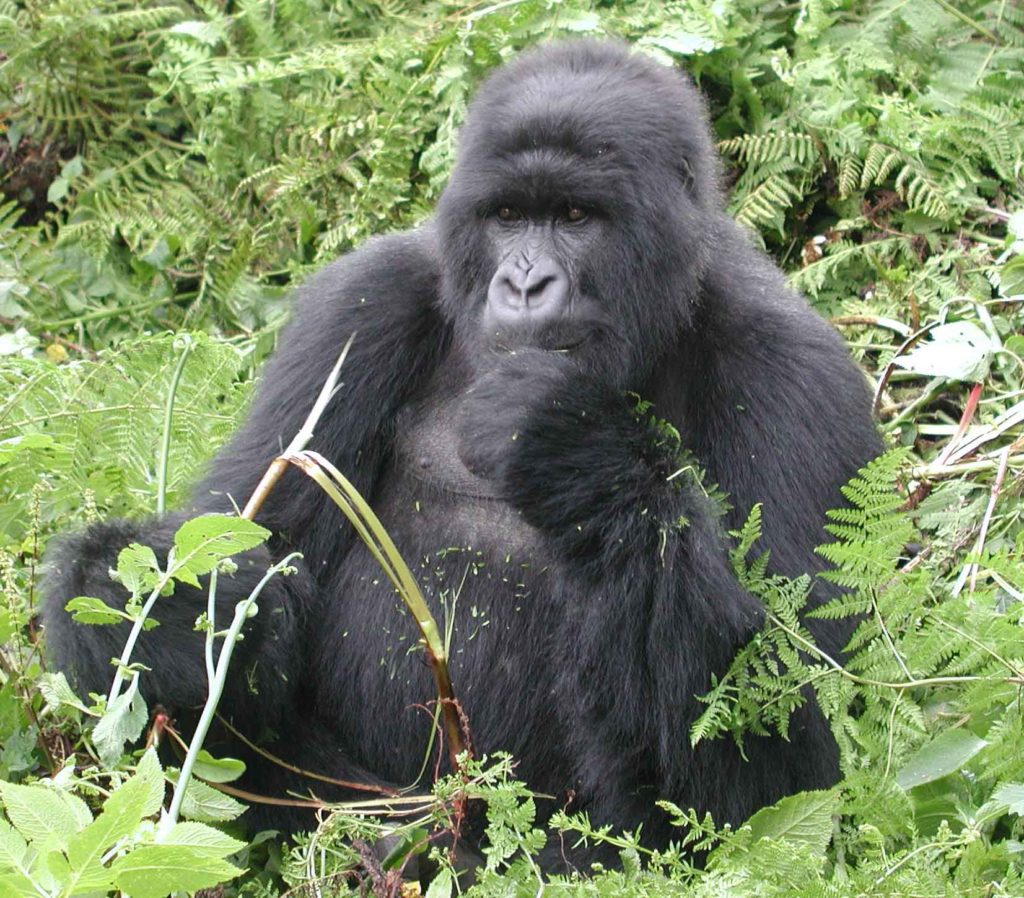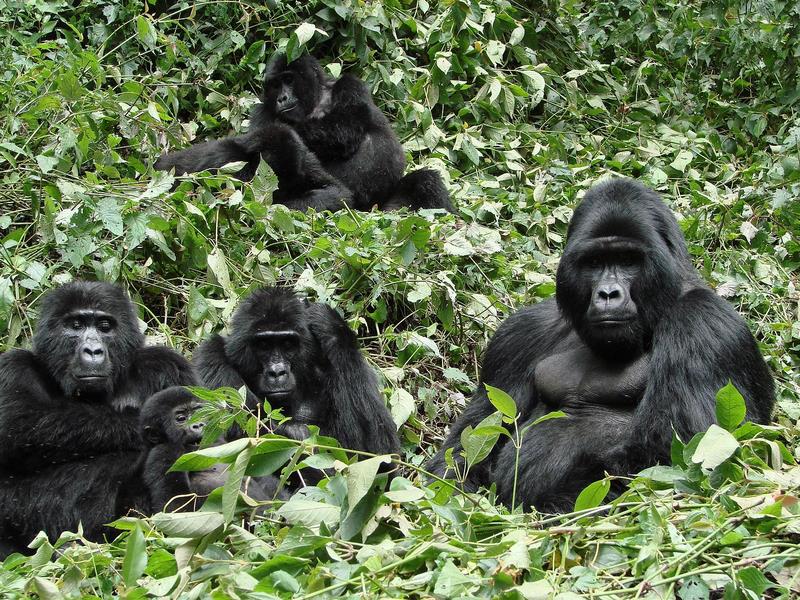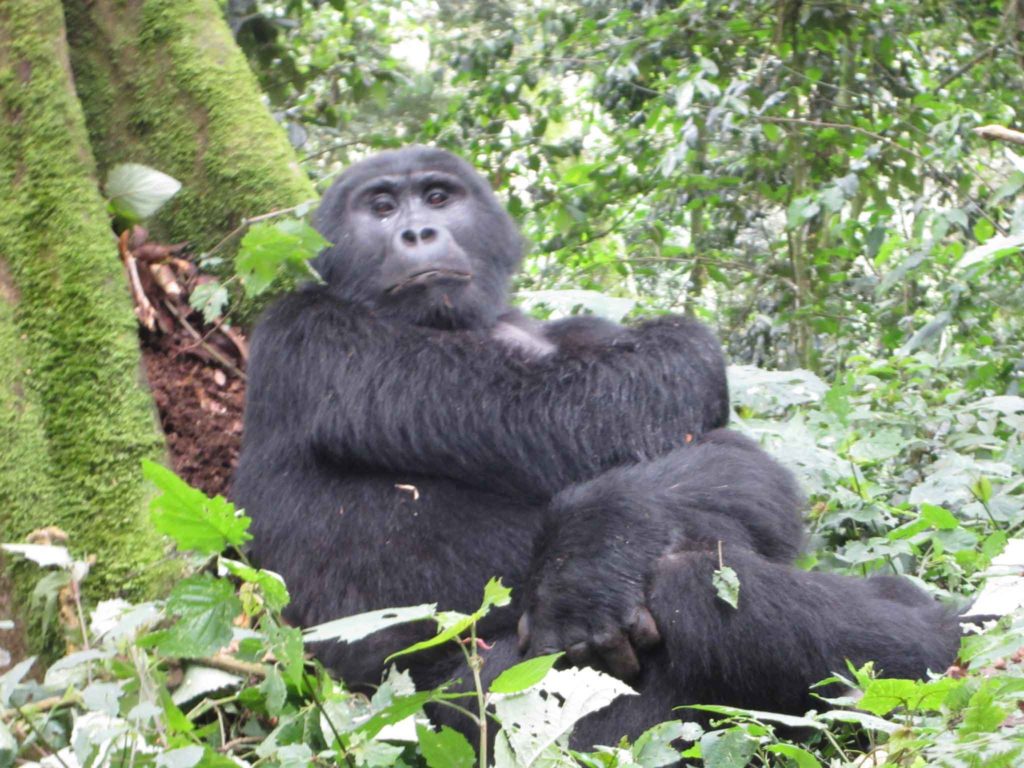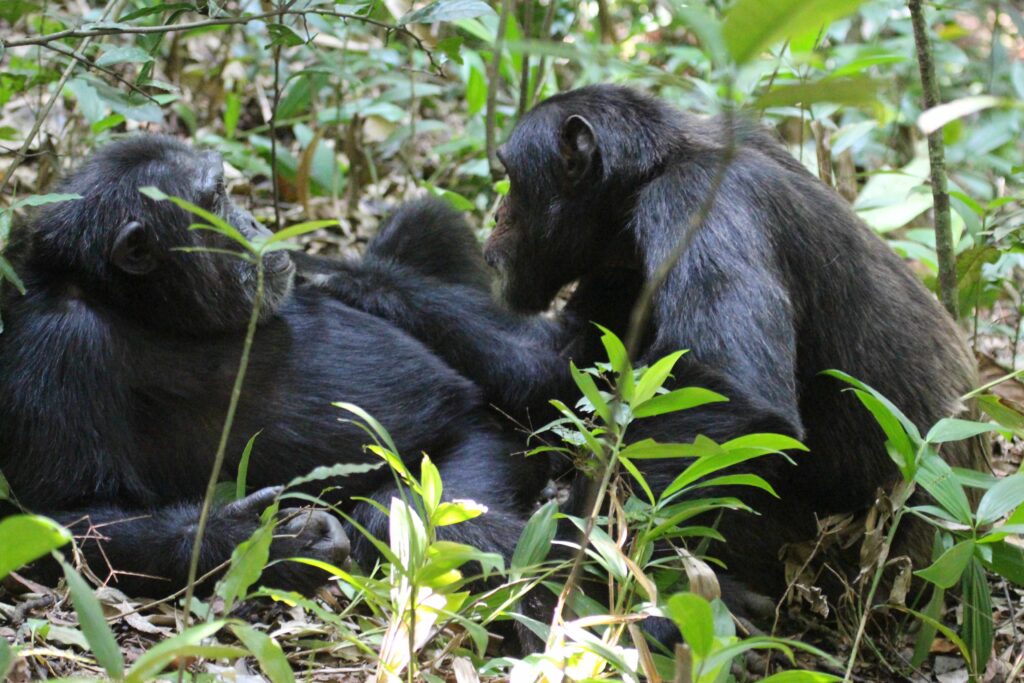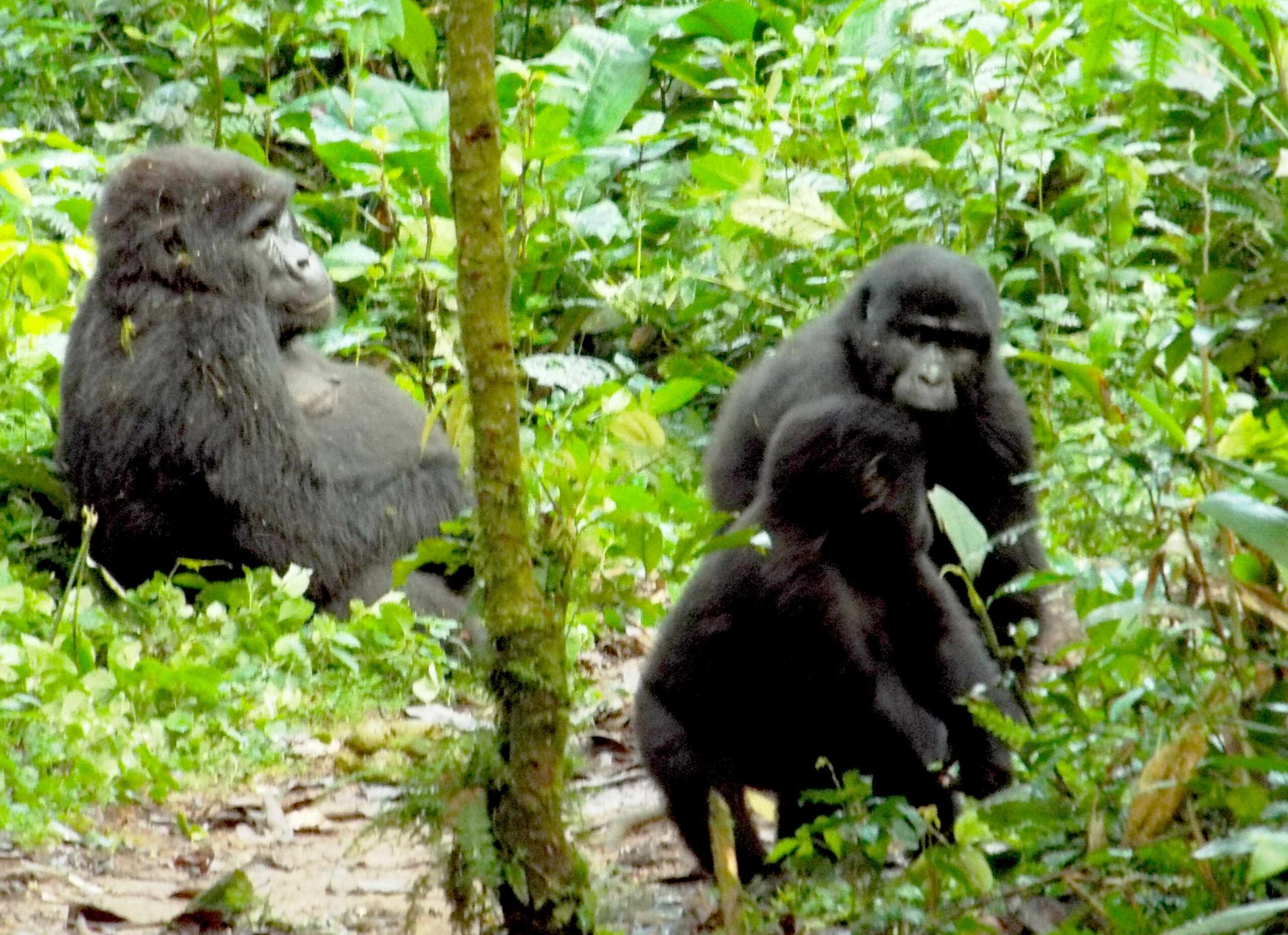
Uganda Primates Tour - Bwindi Gorilla TreKking Kibale Chimp Trek - 5 Days
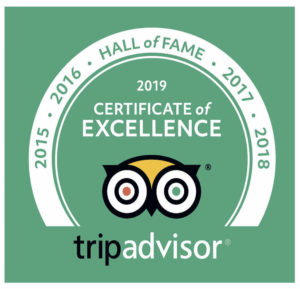 The 5 days Uganda gorilla trekking and chimp tracking tour is the shortest and most comfortable trip to experience the big primates of Uganda. You will be tracking the chimps in Kibale National Park and then gorilla trekking in Bwindi Uganda. We also include guided primates walks in the Kibale area so that you can have the opportunity to experience over 11 primates species in Kibale and Bwindi alone has gorilla trekking but also 10 other primates.
The 5 days Uganda gorilla trekking and chimp tracking tour is the shortest and most comfortable trip to experience the big primates of Uganda. You will be tracking the chimps in Kibale National Park and then gorilla trekking in Bwindi Uganda. We also include guided primates walks in the Kibale area so that you can have the opportunity to experience over 11 primates species in Kibale and Bwindi alone has gorilla trekking but also 10 other primates.
Mountain gorillas trekking can only be done more affordably in Uganda's Bwindi National Park and the permit fee is USD700 per person. The gorilla trekking permit fees and chimps tracking fees are all included in this gorilla tour cost. The gorilla safari can depart on any day so long as gorilla permits are available. You could also opt to start the tour from Kigal and end in Uganda's Kampala or Entebbe. You could also opt to add on this primates' tour an extension safari to Tanzania and Zanzibar.
Uganda Primates Tour - Bwindi Gorilla Trekking Kibale Chimp Trek - 5 Days
- Day 1: Meet in Entebbe or Kampala or at Entebbe Airport, drive to Kibale National Park, and afternoon guided primates walk in Bigodi forest Wetland viewing several monkey species, and probably some chimpanzee troupes along the walk.
- Day 2: Chimpanzee Tracking in Kibale National Park, plus over 10 primates species in the forest.
- Day 3: Drive to Bwindi Impenetrable National Park, home to over 19 families of Uganda's habituated mountain gorillas open for tourism.
- Day 4: Gorilla Trekking in the jungles of Bwindi Impenetrable National Park
- Day 5: Return to Kampala or Entebbe or end tour in Kigali
Kibale has at least 12 other primates species and Bwindi has another 11 primates species. While most of today's forests are no more than 12,000 years old, Bwindi's vegetation has been weaving itself into tangles over at least 25,000 years, in the process accumulating a lengthy species list. This includes 310 species of butterfly, 51 reptiles, 200 trees, 88 moths, and an exceptional 120 types of mammal including 10 primates.
The latter includes chimpanzees, L'Hoest's, red-tailed and blue monkeys, black and white colobus, baboons, and Bwindi's most famous resident, the mountain gorilla.
Bwindi is a prime destination for birdwatchers. Its 350 species include seven which are IUCN red data listed and 90% of all Albertine rift endemics, species which are difficult or impossible to see in any other part of East Africa.
Uganda Primate Tour -Bwindi Gorilla Trekking Kibale Chimp Trek - 5 Days (Gorillas, Chimps Trek)
Day 1: Start the Uganda Primates tour from Airport or your hotel in Entebbe or Kampala, drive Kibale National Park
Briefing on the safari before we drive westwards towards Fort Portal to the Kibale Forest National Park (about 5 hours).
Traveling on both asphalt and unpaved roads, you pass through traditional Ugandan villages where you see people at work tending their traditional crops of millet, sorghum, beans and maize. The lush rolling hills of this region provide good photo opportunities.
As you approach Fort Portal in the foothills of the Rwenzori Mountains, you enter Uganda's famous tea plantation region. A carpet of green spreads before you, as far as the eye can see, and seems an unusual contrast to the countryside through which you have just passed.
You arrive at Fort Portal, then, continue toward Kibale Forest, one of the great African rainforest research reserves. Years of study by scientists (who have cut a grid through the forest) have habituated many of its animals to human observers. This forest is famed for the variety of primates found here and it is a terrific area for birds. This rural Ugandan town (Fort Portal) is locally famous for its weaving and basketry, and we can spend some time briefly to examine some of this local art.
Accommodation options available (all on full board basis)
Up-market: Crater Safari Lodge | Ndali Lodge
Moderate: Isunga Lodge Chimpanzee Forest Lodge | Turaco Treetops
Low Budget: Kibale Forest Camp | Chimpanzee Forest Guesthouse
Day 2: Chimpanzee Tracking in Kibale National Park & Bigodi Wetland Sanctuary
Assemble at Kanyankyu River camp at 08:00 hours to go for the most popular activity in this park which is chimpanzee tracking.
Chimpanzees are man’s closest cousins though they are one of the most threatened primate species. More primates like black and white colobus monkeys, L’Hoest monkeys, grey-cheeked mangabey, red-tailed monkeys, bush babies, pottos and many bird species like the yellow spotted nicator, rumped tinker bird, little greenbul, green-breasted pitta, the crowned eagle, black bee-eater and mammals like elephants can be seen in this walk.
Kibale National Park, which averages about 3,300 feet in elevation, is an extension of the great rainforests of Central Africa. It is inhabited by three large communities of chimps, each numbering more than 100 individuals. Each community has a complicated social structure. The big adult males dominate the group and defend the community territory against incursions by male outsiders; the females usually wander in small family groups.
Typically, we locate the chimps by listening for their pant-hooting calls, then hustle to the area from which they are calling. We get to observe them as they feed in fruiting trees, lounge, and socialise with each other, or even, occasionally hunt.
In the afternoon we visit a nearby forest swamp that is excellent for viewing primates and other forest animals. At the eastern edge of Kibale Forest is Bigodi Wetland Sanctuary which is maintained by the local community. You will expect birds like the great blue turaco, blue monkeys, baboons, otters, mongoose, bushbucks, bush pigs and among others.
Accommodation options available (all on full board basis)
Up-market: Crater Safari Lodge | Ndali Lodge
Moderate: Isunga Lodge Chimpanzee Forest Lodge | Turaco Treetops
Low Budget: Kibale Forest Camp | Chimpanzee Forest Guesthouse
Day 3: Bwindi Impenetrable National Park for the gorilla trek (on day 4)
Depart early morning for Bwindi for your gorilla trek on the next day.
Very early in the morning after breakfast, you will set off for Bwindi impenetrable forest National Park via Kabale- Kisoro route or Isasha Sector with packed lunch. On your way you will enjoy scenery views of different mountains and beautiful plantations.
Accommodation options available (all on full board basis)
Up-market: Mahogany Springs Lodge | Buhoma Lodge |Chameleon Hill Lodge | Nkuringo Gorilla Lodge Bwindi
Moderate: Ichumbi Gorilla Lodge| Engagi Lodge | Lake Mulehe Gorilla Lodge
Low Budget: Gorilla Haven Lodge Rushaga | Gorilla Conservation Camp
Day 4: Gorilla Trekking in Bwindi Impenetrable National Park
After breakfast, proceed for the morning briefing before enjoying the highlight of the trip - gorilla trekking, which may last the entire day.
We trek through the rainforest and bamboo-covered slopes, accompanied by a guide and trackers, in search of a mountain gorilla family. The walking can sometimes be tough and long, but when you catch a glimpse of the magnificent silverback, any discomforts will be quickly forgotten. When sighted, visitors will be guided to within 6 meters from the gorillas, sit around them for a whole hour while gazing into their big round eyes.
Gorilla trekking is unpredictable. It's difficult to foresee how many hours you will hike. The gorilla excursion can take from 2 up to 8 hours. Expect to walk a long distance in steep and muddy conditions, sometimes with rain overhead, before you encounter any gorillas. A good physical condition is recommended. For conservation purposes, time spent with the gorillas is limited to one hour. A ranger will brief you on how to behave with the gorillas.
Accommodation options available (all on full board basis)
Up-market: Mahogany Springs Lodge | Buhoma Lodge |Chameleon Hill Lodge | Nkuringo Gorilla Lodge Bwindi
Moderate: Ichumbi Gorilla Lodge| Engagi Lodge | Lake Mulehe Gorilla Lodge
Low Budget: Gorilla Haven Lodge Rushaga | Ruhija Gorilla Friends Camp | Gorilla Conservation Camp
Day 5: Return to Kampala
Early breakfast before embarking on our return to Kampala, driving down the grassed and terraced escarpments of southwestern Uganda while taking in the breathtaking sights of the hills of the region dubbed ‘the little Switzerland of Africa’.
This area is a highly fertile, mountainous region with steep-sided hills covered from top to bottom in neatly terraced cultivated rows. Not to miss as we traverse Mbarara are the impressing longhorn Ankole cattle.
A remarkable highlight of this journey is the Equator line and surely you will cross it as we have a brief stop here. We will be in Kampala in the evening before your flight back home.
Essential Gorilla Trekking information
Gorilla Trekking takes place in Bwindi Impenetrable National Park in Uganda at altitudes of about 2000 Meters above sea level. Both places experience a modified equatorial climate, which is kind of moist and often cooler. The grounds are usually wet, and the paths are full of stinging plants-nettles. Besides, the rains are random. In this regard, all prospective trackers are asked to bring the following
- Long trousers/ pants- to avoid stinging nettles please do not wear short parks when tracking gorillas. The trousers must be strong enough to withstand occasional pulls from thorns.
- Long-sleeved shirts/ t-shirts. To avoid stinging nettles
- Gloves- not such a big necessity but you may need them to avoid injury to your hands. Remember the grounds are wet and slippery. To avoid injury from thorny bushes and objects on the ground.
- Hiking boots- Please bring average waterproof sturdy walking boots reaching ankle level, not mountain climbing boots. Something light and hardy will do.
- Warm cardigan- the hills can get extremely cold. A warm cardigan is required to keep off cold.
- Long-sleeved Raincoat or anorak -it can rain anytime in Volcanoes National Park even on hot days. The downpours are heavy and extremely cold.
- Waterproof container for your cameras. Yes, I know there are waterproof cameras but even them to be sure just put them in a waterproof container. When you are slipping and falling on muddy grounds you do not want your precious photos damaged or do you?
- If you desire headgear (hats), a baseball cap is recommended as gorillas are familiar to them.
- Enough water- minimum of 2 liters of drinking water to avoid dehydration. Carry four just in case the hike proofs longer than expected. Sometimes it can be 8 hours.
- Film Camera- A film camera for domestic use is recommended.
- A camera
- If you are interested in birds, you can bring a Field guide to birds of East Africa by Fanshawe and a pair of binoculars.
Uganda and Rwanda Introductory Travel Tips
Guide:
Our guide(s) is a thorough English-speaking professional guide and navigates all through.
Meals:
Most of the breakfast served in Ugandan Hotels is English breakfast. Lunch and Dinner in some hotels are based on set menu but most hotels meals are on Ale carte. All hotels included in the Itinerary offer traditional/cultural music shows on request.
Hotels:
We have talked about all the hotels used and their description in the Itinerary: However, not all hotels have Bathtubs, but you will find clean warm shower facilities Ensuite. Some lodges offer Air-conditioned rooms while others haven’t. However, Uganda's climate is renowned for moderate temperatures which range between 18 to 28 degrees centigrade throughout the year.
Safari:
You are on Fullboard(FB)/ Half HB) however this doesn’t stop you from buying anything of your interest.
Porter Service
Services are paid for, or tip is given to hotel peg-boys and porters in parks who may assist in any service offered. (see details of recommended tips).
Open Close Status in General:
All public Tourism sites are open daily from 0700 in the morning to 0700 in the evening.
Seasons
We have two dry seasons a year. All Ugandan roads are good for road transportation all year round.
Dry season: [June, July, and August]; [December, January, and February]. The rest of the Months fall in the rainy season. During the rainy season, activities drop by about 25%.
What vaccinations do I need?
Full vaccination for Covid-19 is highly recommended but it is not a requirement. Nonetheless, all our guides have completed their covid vaccination. S.O.Ps will still have to have to be adhered to.
A yellow fever vaccine is essential – bring your certificate with you.
Be aware that some of these require a course of injections, and others take several days to take effect. So you should visit your doctor or travel clinic as soon as possible before you travel.
Should I bring any other medications?
Anti-malarial tablets are recommended throughout Uganda – visit your local travel clinic to determine which type is best for you. Note: Chloroquine does not protect against malaria in Uganda.
Bring all prescription medications with you – they may not be readily available in Uganda.
Be sure to purchase travel insurance before you begin your trip, including medical evacuation in case of an emergency.
What Other Healthy Risks Are There?
Even if you are taking anti-malarials, you should still wear an insect repellent, long-sleeved shirts, long trousers and closed shoes. This will also help protect you from other diseases carried by mosquitoes, and other insects such as tsetse flies.
All accommodation in high-risk areas will have mosquito nets - be sure to use them.
Avoid swimming in Uganda’s lakes – they carry a high risk of bilharzias.
Tap water is not suitable for drinking, though bottled water is readily available throughout the country.
Tips:
The question of when and when not to tip can be difficult in a foreign country. In Uganda and Rwanda, it is customary to tip your driver/guide at the end of a safari or hike, as well as a cook or porter that accompanies you. A figure if roughly $5 per day would be a fair benchmark, though check this with your safari company in advance. I see no reason why you shouldn’t give a bigger or smaller tip based on the quality of service. It is not essential to tip the guides who take you around in national parks and other reserves, but it is recommended, and the money will be greatly appreciated by the recipient.
The thing to remember is that whoever you tip in USD will not get the sum of money you intend to give. The exchange of USD is not an exact science, the rate given depends on both the age of the note and the size of the note. The newest and biggest denomination note will attract the best rate. A $1 bill will attract an absolute rubbish rate no matter how many you have. A Rwandan / Ugandan will be happy to receive a tip in whatever currency you want to use but for day-to-day living, they prefer their local currency. If you tip them with dollars the first thing, they do is go to the forex to negotiate the best rate available, either that or try and sell them back to you.
So, at the end of the day if all you have is USD or GBP or Euro then use that currency but the best option for the recipient is the local currency (Uganda Shilling or Rwandan franc).
But please please please don't do what some people do, tip using foreign coins, particularly one pound or one-euro coins as they have no value at all and yes, some people do it.
It is customary to tip for service in local bars and restaurants, though you may sometimes want to leave a tip (in fact, given the difficulty of finding change in Uganda), you may particularly be forced into doing this in some circumstances. A tip of 5% would be very acceptable and 10% generous. Generally, any restaurant that caters primarily for tourists and to wealthy Ugandans/ Rwandese residents will automatically add a service charge to the bill, but since there’s no telling where that service charge ends up, it would be reasonable to reward good service with a cash tip.
The following is a guide to tips:
Local guides/porters in the Hotel/ parks US$ 05-10/porter,
Gorilla guides in the park US$ 20-50
Chimpanzee guide in the park US$ 10-30
Game drive guide in the park US$ 10-30
Drivers or Tour Guide US$ 25 per day
Foreign currency exchange, Using credit cards, Bargaining/ Shopping in Uganda
What is the Currency?
The Ugandan Shilling. This cannot be purchased outside the country.
How do I Exchange Cash?
US Dollars, UK Pounds, and Euros are accepted by UWA for gorillas/ chimp tracking permits and park entry fees. Many larger hotels will also accept US Dollars and Euros – though you should check in advance.
Note: All US dollars notes must be printed post-2006 and should not be damaged in any way. Higher exchange rates are given on larger value notes ($50 and $100). Banks and Forex bureaus will exchange cash, alternatively, we can use ATM machines – common in the major towns. They should accept Visa Debit and Credit Cards.
Can I use Credit or Debit Cards?
Visa is more widely accepted in city hotels and stores, followed by Mastercard. Other Credit cards are unlikely to work.
Alert your bank before using your card abroad to avoid it being blocked.
Can I bargain When Shopping
Prices are fixed in shops, but food and craft markets will be more flexible. You stand a better chance of getting a reduced price if you purchase several items from the same seller.
Prices are generally very low – so do consider if what you are asking for is fair.
Agree on charges for mini-busses (matatus) or motorbike taxis (boda-bodas) with your driver before hiring.
What to wear and take when trekking to see the gorillas?
Put on your sturdiest walking shoes, and thick trousers, and a long-sleeved top as protection against vicious stinging nettles. It’s often cold when you set out, so start off with a sweatshirt or jersey (which also help protect against nettles). The gorillas are thoroughly used to people, so it makes little difference whether you wear bright or muted colors.
Whatever clothes you wear to go tracking are likely to get very dirty as you slip and slither in the mud, so if you have pre-muddied clothes, you might as well wear them. When you are grabbing hand-loads of thorny vegetation, a pair of old gardening gloves is helpful. If you feel safer with a walking stick, you will be offered a wooden one at the start of the ascent.
Carry as little as possible, ideally in a waterproof bag of some sort. During the rainy season, a poncho or raincoat might be a worthy addition to your daypack, while sunglasses and a hat are a good idea at any time of the year. You may well feel like a snack during the long hike and should certainly carry enough drinking water - at least one liter, more to visit the Susa Group. Bottled water is sold in Ruhengeri town. Especially during the rainy season, make sure your camera gear is well protected – if your bag isn’t waterproof, seal your camera gear in a plastic bag.
Binoculars are not necessary to see the gorillas. In theory, birdwatchers want to carry binoculars, though in practice only the dedicated are likely to make use of them – the trek up to the gorillas is normally very directed, and walking up the steep slopes and through the thick vegetation tends to occupy one’s eyes and mind.
If you are carrying a lot of gear and food/water, it is advisable to hire one of the porters who hang about at the car park in the hope of work. This costs USD15 per porter. Locals have asked us to emphasize that it is not demeaning or exploitative to hire a porter to carry your daypack; on the contrary, tourists who refuse a porter for ‘ethical reasons’ are simply denying income to poor locals and making it harder for them to gain any benefit from tourism.
- Bwindi Gorilla tracking and Kibale chimps trek permits
- Full board accommodation with all meals either at the lodge or along the way if we are driving for more than 6 hours.
- Bottled drinking water on safari
- All park entrance and related fees
- Private 4x4 ground transportation using a customized safari land-cruiser in the company of a good English-speaking driver guide. You also have local park guides to accompany you on your gorilla tracking in Bwindi and chimps trekking in Kibale National Park.
Talk to Our Uganda Primates Tour Specialist
Enquire about this Gorillas and Primate safari and tour prices.
Talk to our Uganda Primates' Trek Specialist to start planning a memorable primates' experience.
Extend this Uganda safari to Rwanda, Kenya or Tanzania with the following tours:
Rwanda
Rwanda Gorilla Trekking, Cultural Village & Lake Kivu Tour – 5 Days
Rwanda Great Primate Expedition Safari – 9 Days
Rwanda Gorilla, Chimp, Primate & Cultural Tour – 8 Days
Best of Rwanda Safari- Rwanda Gorillas Chimps, Monkey Tour – 6 Days
Rwanda BIG APES: Gorilla Tracking and Chimps Trek Safari – 5 Days
Rwanda Gorilla Trekking Tour – 3 Days
Tanzania
Tanzania Wildebeest Migration Safari – 9 Days
Tanzania Wildlife Safari: Serengeti – Arusha, Tarangire, Ngorongoro Lake Manyara Park – 9 Days
MAIN NATIONAL PARKS FOR YOUR UGANDA PRIMATES' TOUR - GORILLA TREKKING AND CHIMP TRACKING TOURS
Bwindi Impenetrable National Park
The park is located in south western Uganda, covering parts of Rukungiri, Kisoro, and Kabale Districts. It is situated in a hilly country-side that, together with some remnant lowland forest outside the boundary constitutes an important water catchments area for many rivers, supplying the agricultural land of the surrounding region.
Bwindi Impenetrable Forest is a true equatorial jungle, inhabited by four gorilla groups. Amongst the dense vegetation the Columbus monkey jumps from branch to branch, chattering its warning to its fellows hidden by the foliage. Chimpanzees, in families of 20 or 30, make the rounds, searching for fruit and edible plants.
It is situated in a hilly country-side that, together with some remnant lowland forest outside the boundary constitutes an important water catchments area for many rivers, supplying the agricultural land of the surrounding region.
The best time to visit Uganda is late December to late February, and from June to September, as the weather at this time of year is generally dry, and warm. Temperatures average at around 25 degrees Celsius.
Kibale National Park
Once this tropical rainforest provided a (very substantial) dinner, bed and breakfast for large herds of migrating forest elephants and, even now, the park contains the largest population of this subspecies in Uganda. Although they're rarely seen, and dangerous, the signs of these elephants' presence are abundant.
However, Kibale's claim to fame is its enormous variety of primates and its families of habituated chimpanzees - it's home to an astonishing 12 species of primate and provides one of the highest primate densities in the world. Here, on a daytime or evening guided forest walk, you may find families of chimpanzees and red colobus monkeys chattering and swinging through the ancient forest trees.
The sightings of birds in the forest are no less impressive - there are at least 325 species, many of which are found nowhere else. In addition, there are over 144 species of butterflies.
THE MOUNTAIN GORILLA TREKKING EXPERIENCE
Mountain gorillas are wild animals and, as such, sightings cannot be guaranteed. However, for the last 14 years, no one has trekked the gorillas and failed to see them in Uganda. Certainly, you won't be the one with bad luck! On the trek, once you find the gorillas, you will be allowed an hour with the gorillas and you can only go not more than 6 meters from them. As the gorilla tracking can sometimes take a full day, you will need to go with your packed lunch and lots of drinking water when trekking to the gorillas.
Gorilla trekking timings and conditions vary tremendously as the gorillas move continuously through the rain forest. It is good to be prepared and remember the weather can change with very little warning. The terrain is often steep and through areas where there are no marked paths.
TIPS FOR THE BEST GORILLA TREKKING EXPERIENCE IN UGANDA
Secure Gorilla Trekking permits early
Gorilla Trekking is the most popular foreign tourist activity for Uganda. On every single day, only 128 tourists can trek the gorillas in Bwindi. Uganda has the cheapest gorilla permits prices at USD600 (or USD700 beginning July 2020) for safe gorilla tracking as Rwanda's gorilla permits cost USD1500. This means the competition is quite high for the few gorilla permits in Uganda and it becomes hard to secure gorilla trekking permits a few days to your Uganda gorilla tour (although it is often possible with luck more so in the green season months of October, November, April and May). It is best to have your gorilla trek permit fully confirmed at least 4 months in advance.
Assess your fitness levels
There is a likelihood you could walk for 3-6 hours on a gorilla trek. Gorillas are located deep in Bwindi forest with thick undergrowth over several steep volcanic slopes. Gorilla groups keep roaming this forest looking for their favorite food. They are never stationed in the same place over days. Your gorilla trek will follow this same trend and it is quite unpredictable knowing how long or tough your gorilla trekking shall be. The longer trek is not necessarily a problem, just something to be prepared for. A bit of moderate physical fitness is needed for gorilla trekking in Uganda.
Guides & Porters for the gorilla trek
You will be guided through the forest on your gorilla tracking by a Uganda Wildlife Authority guide whom you will meet at the departure point in the morning of your trek. Your guide can help you book a porter (or two!) so that you can track without having to carry the few essential items listed below in a day pack which you should bring with you. The porters are from the local community and very used to the local conditions and can assist in pushing, pulling and supporting you during your trek to the gorillas. They are usually an additional fee, over and above your safari cost, and you should budget on approximately USD15-20 per porter per day as a fee with additional tipping being optional.
As the porters do not have tracking permits they will be stopped a short distance from the point you will be viewing the mountain Gorillas. Please remember to take whatever you may need from your bag to view the gorillas and rather leave valuables at the lodge/camp.
You will be allowed up to one hour for viewing of the gorillas from when they are sighted by your group. This is to ensure that the wild animals are not overexposed to human presence. Whilst in their presence you will also be required to keep minimum distances from them – generally between 5-7 metres and your guides will ensure this is enforced.
What to pack on gorilla trekking
• Plenty of water – 1-2 litres per person
• High energy snacks in addition to your packed lunch provided by the lodge/camp
• Spare film and batteries for videos and cameras
• Gloves (gardening type are good)
• Waterproof bag to protect photographic equipment
• A hat, sunscreen, mosquito repellent and band-aids might be useful
• A lightweight waterproof jacket/poncho
• Walking sticks are made available at the start of the trek for some of the steeper and more slippery tracks and may prove to be very handy.
Gorilla Trekking Age Limits
The age limit for gorilla trekking is 15 years and the authorities are very strict on this! With special written permission however, a 14yr old might pass.
Videos & Photography for Gorilla Trekking in Uganda
In Uganda, it can be difficult to capture good photos under the dark canopy of Bwindi Impenetrable Forest, as the name suggests! If you are very lucky, you may encounter your gorilla family in a clearing.
Here are a few tips for photographing the gorillas in Uganda:
- If you’re taking photos using a standard point-and-shoot camera, then make sure your camera is fully charged.
- Always take extra memory cards.
- Remember that flash photography is not allowed when you are with the gorillas. Make sure you have your camera manual with you so you know how to disable the automatic flash and automatic focus light functions.
- We recommend a good SLR camera. The best lenses are those with a wide aperture such as f2,8 which allow in max light and are best in gloomy conditions. A 24 – 70 mm and a 70 – 200 m is a good combination. If you have space then consider a 300mm and a wide angle but it’s a steep walk so consider hiring a porter. A 50 mm 1.4 lens is also ideal for low light shooting and something to consider as a standard lens.
- Professional filmmakers require permission and need to purchase filming permits in advance from UWA (Uganda) or RDB (Rwanda).
- Keep your camera and/or phone in a waterproof bag (such as a large Ziploc bag). Cue: you’re in the rainforest.
Professional photographers, film makers or media should advise us at the time of booking as special procedures are required as well as costs to be incurred for photographing and filming.

